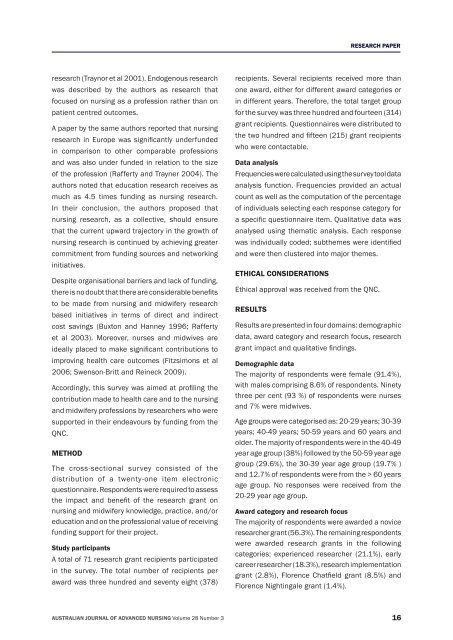australian journal of advanced nursing
australian journal of advanced nursing
australian journal of advanced nursing
You also want an ePaper? Increase the reach of your titles
YUMPU automatically turns print PDFs into web optimized ePapers that Google loves.
esearch (Traynor et al 2001). Endogenous research<br />
was described by the authors as research that<br />
focused on <strong>nursing</strong> as a pr<strong>of</strong>ession rather than on<br />
patient centred outcomes.<br />
A paper by the same authors reported that <strong>nursing</strong><br />
research in Europe was significantly underfunded<br />
in comparison to other comparable pr<strong>of</strong>essions<br />
and was also under funded in relation to the size<br />
<strong>of</strong> the pr<strong>of</strong>ession (Rafferty and Trayner 2004). The<br />
authors noted that education research receives as<br />
much as 4.5 times funding as <strong>nursing</strong> research.<br />
In their conclusion, the authors proposed that<br />
<strong>nursing</strong> research, as a collective, should ensure<br />
that the current upward trajectory in the growth <strong>of</strong><br />
<strong>nursing</strong> research is continued by achieving greater<br />
commitment from funding sources and networking<br />
initiatives.<br />
Despite organisational barriers and lack <strong>of</strong> funding,<br />
there is no doubt that there are considerable benefits<br />
to be made from <strong>nursing</strong> and midwifery research<br />
based initiatives in terms <strong>of</strong> direct and indirect<br />
cost savings (Buxton and Hanney 1996; Rafferty<br />
et al 2003). Moreover, nurses and midwives are<br />
ideally placed to make significant contributions to<br />
improving health care outcomes (Fitzsimons et al<br />
2006; Swenson‑Britt and Reineck 2009).<br />
Accordingly, this survey was aimed at pr<strong>of</strong>iling the<br />
contribution made to health care and to the <strong>nursing</strong><br />
and midwifery pr<strong>of</strong>essions by researchers who were<br />
supported in their endeavours by funding from the<br />
QNC.<br />
METHOD<br />
The cross‑sectional survey consisted <strong>of</strong> the<br />
distribution <strong>of</strong> a twenty‑one item electronic<br />
questionnaire. Respondents were required to assess<br />
the impact and benefit <strong>of</strong> the research grant on<br />
<strong>nursing</strong> and midwifery knowledge, practice, and/or<br />
education and on the pr<strong>of</strong>essional value <strong>of</strong> receiving<br />
funding support for their project.<br />
Study participants<br />
A total <strong>of</strong> 71 research grant recipients participated<br />
in the survey. The total number <strong>of</strong> recipients per<br />
award was three hundred and seventy eight (378)<br />
RESEARCH PAPER<br />
recipients. Several recipients received more than<br />
one award, either for different award categories or<br />
in different years. Therefore, the total target group<br />
for the survey was three hundred and fourteen (314)<br />
grant recipients. Questionnaires were distributed to<br />
the two hundred and fifteen (215) grant recipients<br />
who were contactable.<br />
Data analysis<br />
Frequencies were calculated using the survey tool data<br />
analysis function. Frequencies provided an actual<br />
count as well as the computation <strong>of</strong> the percentage<br />
<strong>of</strong> individuals selecting each response category for<br />
a specific questionnaire item. Qualitative data was<br />
analysed using thematic analysis. Each response<br />
was individually coded; subthemes were identified<br />
and were then clustered into major themes.<br />
ETHICAL CONSIDERATIONS<br />
Ethical approval was received from the QNC.<br />
RESULTS<br />
Results are presented in four domains: demographic<br />
data, award category and research focus, research<br />
grant impact and qualitative findings.<br />
Demographic data<br />
The majority <strong>of</strong> respondents were female (91.4%),<br />
with males comprising 8.6% <strong>of</strong> respondents. Ninety<br />
three per cent (93 %) <strong>of</strong> respondents were nurses<br />
and 7% were midwives.<br />
Age groups were categorised as: 20‑29 years; 30‑39<br />
years; 40‑49 years; 50‑59 years and 60 years and<br />
older. The majority <strong>of</strong> respondents were in the 40‑49<br />
year age group (38%) followed by the 50‑59 year age<br />
group (29.6%), the 30‑39 year age group (19.7% )<br />
and 12.7% <strong>of</strong> respondents were from the > 60 years<br />
age group. No responses were received from the<br />
20‑29 year age group.<br />
Award category and research focus<br />
The majority <strong>of</strong> respondents were awarded a novice<br />
researcher grant (56.3%). The remaining respondents<br />
were awarded research grants in the following<br />
categories: experienced researcher (21.1%), early<br />
career researcher (18.3%), research implementation<br />
grant (2.8%), Florence Chatfield grant (8.5%) and<br />
Florence Nightingale grant (1.4%).<br />
AUSTRALIAN JOURNAL OF ADVANCED NURSING Volume 28 Number 3 16

















